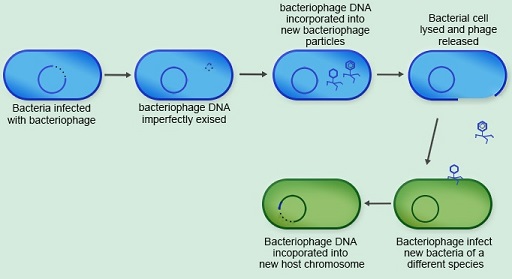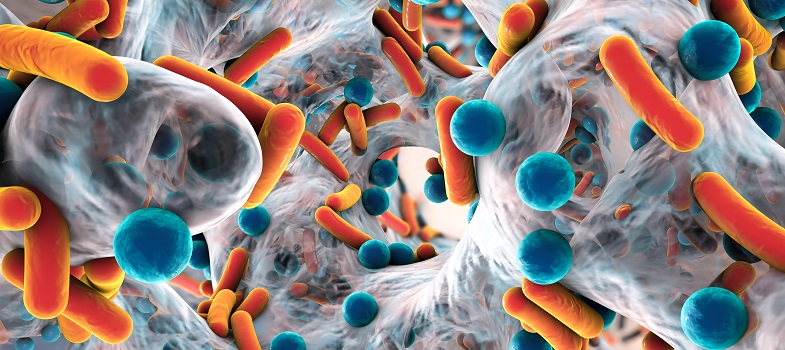3.2.4 Transduction
The final mechanism of horizontal gene transfer you will look at is transduction. In this process, transfer of DNA from one bacterial cell to another is mediated by a virus.
Viruses that infect bacteria are called bacteriophages. When a bacteriophage infects a bacterial cell, it inserts its DNA into the bacterial cell genome. When it is time for the virus to replicate, it excises its DNA from the bacterial genome. However, this excision is imperfect and some bacterial DNA may be accidentally excised and incorporated into the newly made virus. When these newly made viruses infect a different bacterial species, they carry this bacterial DNA, which may contain antibiotic resistance genes, and insert it into the genome of the new host bacterium (Figure 27).

Figure 27 Schematic diagram of transduction. When bacteriophage DNA, shown by a dotted line, is excised from the bacterial genome it carries with it some bacterial DNA, shown as a solid line, from the infected bacteria. (You should view the larger version of this image to see the dotted line clearly.) this DNA is incorporated into new bacteriophage particles which are released and infect new bacteria of a different species. The bacterial DNA from the original bacteria is incorporated into the genome of the newly infected bacteria.
Show description|Hide descriptionThis figure is a schematic representation of transduction. Bacterial cells of one species are represented as blue ovals. The bacterial DNA is represented as a blue circle. Bacteriophage DNA is represented in a black dotted line. Bacteria infected with bacteriophage have bacteriophage DNA incorporated into their DNA. When this DNA is excised from the bacterial genome if carries with it some bacterial DNA. This DNA is incorporated into new bacteriophage particles which are released and infect new bacteria of a different species (in green). The bacterial DNA from the original bacteria, in blue, is incorporated, together with the bacteriophage DNA (in red) into the genome of the newly infected bacteria (in green).
Activity 9: Comparing horizontal transfer mechanisms
Timing: Allow about 5 minutes
Use the drop-down options to complete the five sentences below.
Active content not displayed. This content requires JavaScript to be enabled.
Interactive feature not available in single page view (
see it in standard view).




